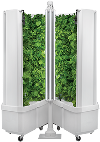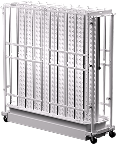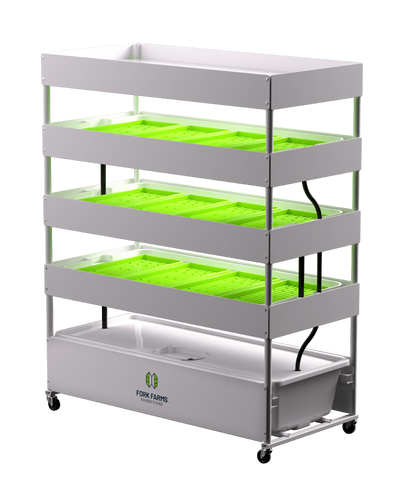What to Grow in a Hydroponic Garden
Discover the top plant varieties that thrive in hydroponic gardens and learn how to grow them successfully in your indoor hydroponic garden.
Hydroponic growing is a method of cultivating plants without soil. Instead, plants are grown in a nutrient-rich water solution that provides all the essential elements they need to grow. This method allows for precise control over the growing conditions, resulting in faster growth and higher yields.
In hydroponic gardens, plants are typically grown in containers filled with an inert growing medium, such as rockwool, perlite, vermiculite, or coconut coir. The roots are directly exposed to the nutrient solution, which is circulated using a pump and an irrigation system.
One of the key advantages of hydroponic growing is that it eliminates the need for soil. It also allows for year-round gardening, as the indoor environment can be controlled to provide optimal conditions regardless of the season.
Overall, hydroponic growing offers a sustainable and efficient way to grow plants, making it a popular choice for people looking for a way to grow nutritious, year-round fresh produce.
Benefits to Growing Plants Hydroponically
Higher yields: The controlled environment of hydroponic gardens allows for optimal growing conditions, leading to increased productivity and higher crop yields.
Faster growth: With precise dosing, plants receive the perfect combination of nutrients and minerals, allowing them to focus their energy on rapid growth and robust development. This results in accelerated and vigorous plant development, ensuring optimal growth conditions.
Water efficiency: Hydroponic gardens use significantly less water compared to traditional soil-based cultivation. The water is recirculated within the garden, reducing water waste.
Space-saving: Hydroponic gardens can be set up vertically, maximizing the use of limited space. This makes them ideal for small rooms or unused environments such as unused classrooms or closets.
Pest and disease control: Without soil, many common pests and diseases that affect traditional gardening are minimized or eliminated, reducing and/or eliminating the need for pesticides and fungicides.
These advantages make hydroponic growing an attractive option for both commercial growers and novice gardeners.
Choosing the Right Plants for Hydroponic Gardens
Not all plants are suitable for hydroponic growing. Here are some of the best plants that thrive in hydroponic gardens.
Leafy greens: Lettuces such as romaine, summer crisp, and butterhead are excellent choices for hydroponic cultivation. They can be harvested whole or multiple times, making them highly productive. Spinach, kale, and Swiss chard are other leafy greens that grow well but need additional care during germination.
Herbs: Basil, parsley, and cilantro are well-suited for hydroponic growing. They can be grown year-round and provide fresh flavors for your culinary creations. Additionally, rosemary, thyme, sage, and oregano grow well in hydroponics but do take longer to mature.
Tomatoes: Compact varieties of tomatoes, such as cherry or grape tomatoes, can be successfully grown in hydroponic gardens. They require support for their vines but can yield delicious fruits.
Cucumbers: Mini cucumber varieties thrive in hydroponic gardens. Choosing a compact vining variety will ensure you don't run out of space since the vines love to climb. You'll also want to provide support for their vines - especially when the fruit starts to grow.
Strawberries: Hydroponic gardens provide an ideal environment for growing strawberries.
Peppers: Different pepper varieties, such as bell peppers and chili peppers, thrive in hydroponic setups. They require support for their stems as they reach maturity. They can be harvested when they reach the desired size and color.
These are just a few examples of fresh food that can be grown hydroponically. Experiment with different varieties to find the best ones that suit your taste and growing conditions. For detailed information on the nutritional value of these foods, you can visit the U.S. Department of Agriculture’s FoodData Central.
Plants That Can't be Grown in a Hydroponic Garden
Although you can cultivate various plants using a hydroponic garden, some may pose difficulties. Root vegetables such as carrots, onions, and beets, as well as larger, heavier varieties like cauliflower, might not thrive in a vertical hydroponic garden. At Fork Farms, we suggest that you grow these crops in your outdoor gardens instead.
Tips to Successfully Grow in a Hydroponic Garden
Here are some additional tips to ensure successful hydroponic gardening with whatever plant variety you choose.
Start with easy-to-grow plants: If you're new to hydroponics, begin with plants like lettuce or certain herbs. Once you gain experience, you can gradually expand into different herbs, vining, and fruiting plants.
Maintain cleanliness: Keep your hydroponic garden clean and free from debris or algae. Regularly clean the irrigation lines, pumps, and other components to prevent clogs or contamination.
Monitor water quality: Test the water regularly for pH and nutrient levels. Adjust as necessary to maintain optimal conditions for plant growth.
Provide proper ventilation: Ensure good air circulation within your indoor garden to prevent the buildup of excess heat or humidity. This can be achieved through the use of fans or vents.
Consider plant spacing: Give your plants enough space to grow and spread their roots. Crowding can lead to competition for nutrients and hinder growth.
Learn from others: Join online communities or local gardening groups to exchange tips and experiences with fellow hydroponic growers. You can learn valuable insights and troubleshoot any challenges you may encounter.
At Fork Farms, you can join the Farmative Community once you purchase a Flex Farm. In the community, you are able to collaborate with like-minded, innovative growers. You can ask questions, share, and celebrate your harvests. Furthermore, the Farmative has guides and information on growing leafy greens, herbs, and fruiting plants. These include a comprehensive growing guide for leafy greens, an herb growing guide focused on seed bundles, an experiment guide for fruiting plants, and recommended plant varieties for your hydroponic garden.
With these tips in mind, you'll be well on your way to successfully growing fresh food in your hydroponic garden. Enjoy the benefits of growing fresh and healthy plants right in your place of work, school, or community center!
Contact our team of experts to learn more about what you can grow in the Flex Farm and maximize your yields. You can also check out our Grow Guide Video Series to discover more about growing hydroponically in the Flex Farm.























